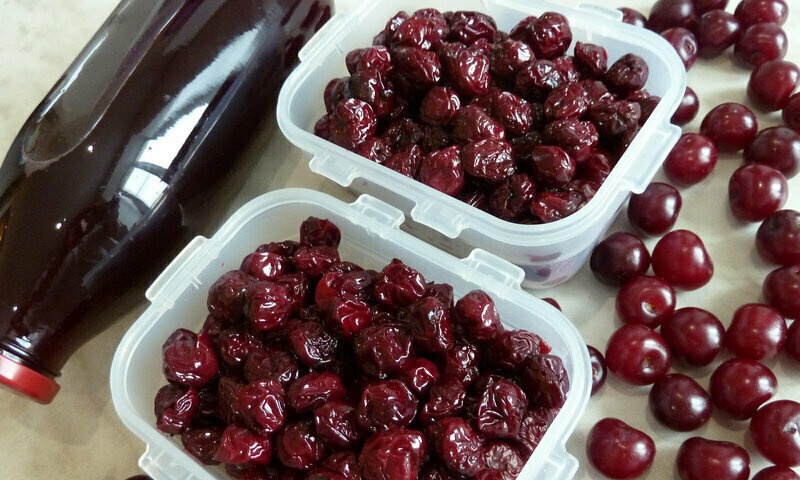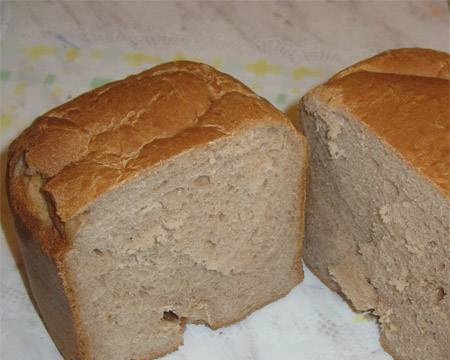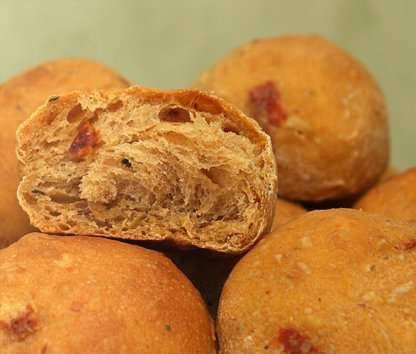This is how Lyudmila's (mariana-aga) original article about Calvel's leaven in LJ looked like. Without any fixes:
"How to create a thick sourdough for bread dough. Sourdoughs on wheat and rye flour. Recipe of Prof. R. Kalvel.
Translation of an article from English for those who balk and want everything to be in Russian!
***
My friend Eric once asked me how I can create a working leaven of bread in two to three days, because usually books describe a process that takes more than two weeks. Well, listen to my story.
I started baking sourdough bread this spring. The first starter cultures were purchased by me in powder (dried form) from Ed Wood, owner of Sourdough International. Everything was fine until I read Calvel's Taste of Bread book and his articles. Calvel made such an impression on me that I then threw all my exotic starter cultures (which I unknowingly spoiled by keeping in the refrigerator) into the trash can and now I bake on "homemade" ones.
Professor Raymond Calvel was a French baker (he had a university degree in chemistry). He baked bread and taught others how to bake bread for seventy years. Even in captivity during the Second World War, he was assigned to bake bread in a small village for the German troops. The great and wonderful Julia Child learned how to bake bread with Calvel.
Culvel's biography can be read here:
I first tried Calvel's method out of pure curiosity, because he excited me by saying that a working culture of lactic acid bacteria and wild yeast can be created in two and a half days. Before I read Calvel, my experience with starter cultures was more laborious and time consuming with more problems as the starter was reconstituted from a dry form (purchased) or homemade from plain flour and water. Even the sourdoughs from Sourdough International (which I warmly recommend to everyone who wants to taste the amazing aromas of foreign breads - Samarkand flatbreads, French farm breads, Austrian or Finnish black, Palekh white loaf, etc.) required at least five days to activate and absolutely everything every single one passed through the phase of infection with unwanted microflora in the first 2-3 days of their recovery from a dry form. I had to rinse them many times before they flattened out and turned into real liquid bread leavens.
I also tried Calvel's Method of Need, because Calvel says in his book that the microbiota in starter cultures changes if we store them in the refrigerator at temperatures below 10-12C. IBCs do not survive at these temperatures. Oh! All my starters went to the trash! Every single one. I was terribly angry then (so much work was put into those leavens!) And at the same time I felt relief - it's better to know the truth than to live in dark ignorance. I'm happy today. My fermented milk cultures are excellent. The best.
To create a working leaven for bread in two to three days, start with the right kind of bread flour. I created my very first sourdough according to Calvel following a recipe from a book, where it all starts with a mixture of two cups of wheat bread flour (unbleached white, i.e. c. Or 1c. If according to the Russian nomenclature) and two cups of wallpaper rye flour (dark ) moistened with water until a very tough dough is obtained, like dumplings. This dough is mixed with a little salt and malt (in the form of flour from sprouted grains of rye or oats, or in liquid form, like water or syrup). In Russia, malt is known to everyone in the form of kvass concentrate. You can take it.
In grams
300g flour 1s
300g peeled rye flour
360 g water
3 g salt
3 g malt
Knead the dough thoroughly, really knead. Hands. Knead for about five minutes. Let sit for 20 minutes and knead with your hands for another 20 minutes.
The salt will protect the proteins of the wheat flour from the attack of the proteolytic enzymes contained in the flour (i.e., thanks to the salt, the dough starter will not turn into a sticky slurry, but will remain a plump, fluffy dough with pronounced porosity). Protease softens the dough, but if you give it the will and time, then during the first 20 hours of fermentation of the dough, it will corrode the flour gluten so much that there will be a liquid inside the doughball.
Malt is added to improve the amylolytic capacity of flour, i.e. malt helps to convert particles of inedible starch in flour into simple sweet sugar, which microorganisms like lactic acid bacteria and wild yeast readily feed on.
Wheat flour is taken unbleached. In America it is sold under the name "bread" flour. Or you can use unbleached all-purpose flour. In Russia, in my opinion, all flour is unbleached chemically. So take 1c. or in. with .. The main thing is not pastry flour and not pancake flour, but such from which you can make pies.
Rye flour is taken from the French type No. 170. In North America, it is a mixture of 225g gray rye with 75g dark rye. flour. In Russia, take whatever rye flour is, or even hzhan flakes or rye in the form of grain. You will still get sourdough, you'll see!
To increase the production of acetic acid in the sourdough in the first hours of its life, i.e. in order to disinfect it from unwanted microorganisms such as E.coli, mold and other monsters, you can add 25 g of honey to the very first sourdough dough.
In Calvel's recipe for European flours, he indicates 300g of water per 600g of flour, i.e. 50 baking percent. In America, this will be approximately 58-62% of water to flour, that is, for 600 g of flour, take 348-372 g of water.
Well. She described everything. So the process is step by step
1) Make a sourdough from 600 g of a mixture of wheat and rye flour with salt, malt and honey (if you wish). Knead the tough dough in water and leave warm, under a plastic wrap or towel. At 22 hours. I have the warmest place in the kitchen - in the cabinet above the refrigerator. There I have a stable temperature of 27C.
2) 22 hours later, refresh the leaven. Throw half in the trash and mix the other half with fresh flour and water. 300g old sourdough, 2 cups flour (wheat), 180g water, 1.5g salt, 2g malt. Knead properly and leave for 5-7 hours warm at room temperature (about 25-27C). At best, you will see that by the end of this period the leaven will triple in volume. But no, no, it will swell anyway. Let's continue.
3) So, 5-7 hours have passed. It's time to feed the leaven. Throw half in the trash and mix the other half with flour and water. Add no more malt or salt. 300g old sourdough, 2 cups wheat flour, 180g water. Knead and leave for 17 hours at cool room temperature (around 15C) or 7 hours at very warm room temperature (28C). By the end of this period, the leaven will almost quadruple in volume.
4) Well, it's been 48 hours since we first kneaded the leaven. It is necessary to feed it 2-3 more times before putting bread dough on it. Feed every 5-7 hours to make sure that the leaven perfectly raises the dough in volume by 400% in 5-7 hours at room T at 27-28C. These dressings do not need to be done according to the method of 300g old + 300g fresh dough (from two cups of flour and 80g of water). At this stage, it is already possible to drastically reduce the amount of starter with which you work, well, to 50-100 grams, if you like.
Also, starting from this moment, you can create sourdoughs for different types of dough: pure rye (dark or white), peeled wheat, various grains, etc. Just take a piece of old dough starter and feed it with the flour we need for several cycles. future bread dough.
What you can't do is convert the leaven from a thick (like dough for dumplings) to a liquid form (like a pancake dough) until your dense leaven is three full days old and has gone through 4-5 refreshing cycles. This is important so that it has the correct acidity, which protects it from being infected by microorganisms we do not need.
So, two and a half - three days after kneading the first sourdough bun, you have an excellent bread leaven and you can put bread dough on it or create a sourdough for storage.
Notes
This starter can also be created at normal room temperature of 21C. At this temperature, neither LAB nor wild yeast have any advantages, that is, their populations in the dough leaven develop at approximately the same rate. It is very important that the temperature of the starter culture is not higher than 27-28C, because at 27C the number of yeast cells in the dough doubles the fastest - every hour. At higher temperatures - 30-35-40C, the yeast is inhibited and begins to die.
We are all living normal people with our own worries and employment. You don't have to stand next to the sourdough with a stopwatch. The feeding schedule is approximate. Plus or minus an hour or two doesn't matter. In any case, by the end of the third day, the leaven will be ready.
A ready-made sourdough not only knows how to raise the dough 4 times in volume in 6 hours or faster (i.e., in 3 hours, for example, and there are such sourdoughs). It should also have good acidity. The pH of the finished starter culture will be in the range 4.4 - 4.6. If you're interested, measure it with litmus paper.
Sourdough bread does not have to be 100% pure leavened wild yeast and LAB. In sourdough bread dough, you can add baker's yeast in an amount of 0.1-0.2% (i.e. 1.5-3 g of pressed yeast for each liter of water that goes into the dough) at the time of kneading the final bread dough. Such small amounts of baker's yeast will not in any way affect the taste and appearance of sour bread, but they will allow us to shorten the proofing time of finished products. The time of proofing of products with pure sourdough can take up to 5-8 hours.
Illustrations
Gingerbread man of various grains (from several kinds of flour, flax seeds, etc.) It smells like apples









